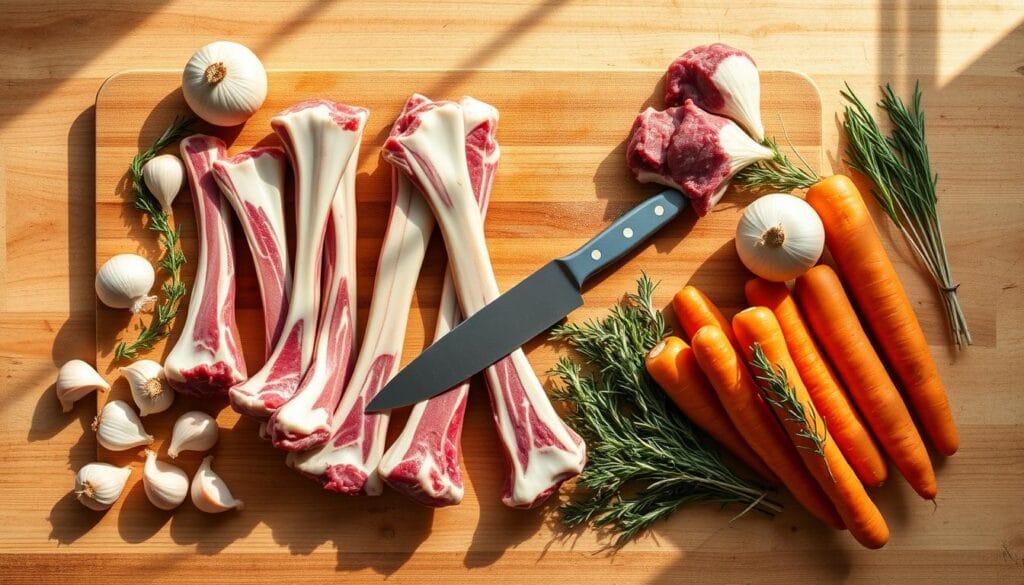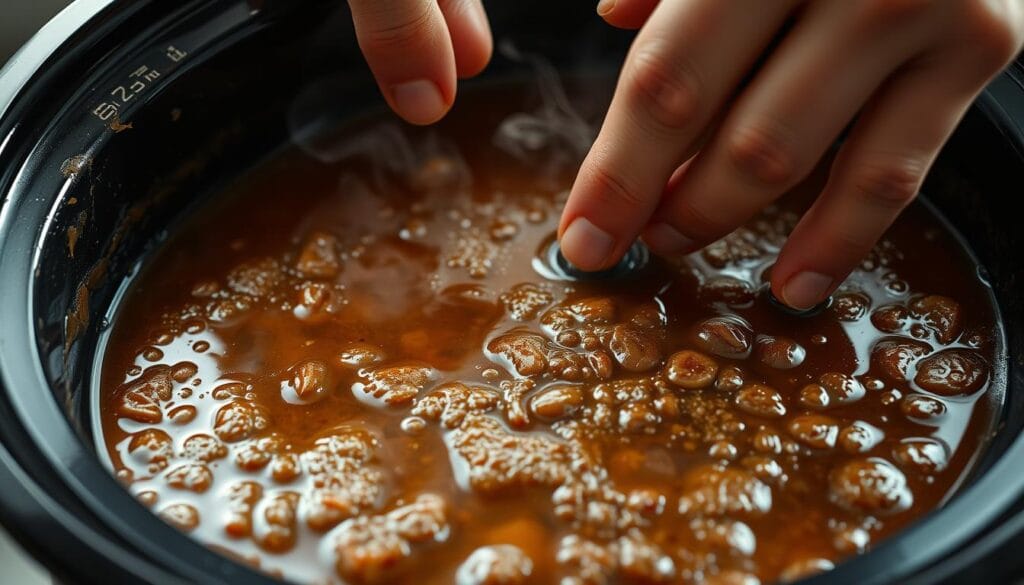Slow Cooker Beef Neck Bones Recipe for Tender Meat
Beef Neck Bones Recipe
There’s something magical about turning an underrated cut into a dish that feels like a warm hug. Imagine coming home to the aroma of tender, fall-off-the-bone meat that’s been simmering all day. That’s exactly what this slow cooker method delivers.
This recipe is all about simplicity. With just a handful of ingredients and a hands-off approach, you can create a meal that’s both comforting and gourmet. The slow cooker does the heavy lifting, allowing the flavors to meld perfectly over time.
Beyond the taste, there’s a rich cultural heritage behind using this cut. It’s also packed with nutrients, making it a wholesome choice for any meal. Whether you’re a seasoned cook or a beginner, this dish is foolproof and sure to impress.
Table of Contents
Key Takeaways
- Transform an underrated cut into a gourmet meal with minimal effort.
- Use simple ingredients and let the slow cooker do the work.
- Enjoy tender, fall-off-the-bone results every time.
- Learn about the cultural and nutritional benefits of this dish.
- Perfect for both beginners and experienced cooks.
Introduction and Background
For generations, humble cuts have been the heart of family meals, bringing comfort and flavor to the table. These ingredients, often overlooked, carry a rich history and cultural significance. They remind us of a time when resourcefulness in the kitchen was essential, and every part of the animal was cherished.
Embracing the Rich Tradition of Neck Bones
In many cultures, certain cuts have become staples in traditional recipes. They were not just ingredients but symbols of family gatherings and shared moments. Slow cooking these cuts allowed the flavors to develop deeply, creating meals that were both nourishing and memorable.
This method of cooking was passed down through generations, preserving techniques that highlight the natural richness of the ingredients. Today, these traditions continue to inspire modern adaptations, blending old-world charm with contemporary tastes.
Nutritional and Flavor Benefits
Slow cooking not only enhances flavor but also unlocks the nutritional potential of these cuts. The process breaks down connective tissues, resulting in tender, fall-apart meat. Additionally, the broth produced is rich in collagen, which supports joint health and overall well-being.
Here’s a quick look at the nutritional benefits of this cooking method:
| Nutrient | Benefit |
|---|---|
| Protein | Supports muscle repair and growth |
| Collagen | Promotes skin elasticity and joint health |
| Iron | Boosts energy and supports blood health |
| Zinc | Strengthens the immune system |
By embracing these time-honored techniques, you can create meals that are not only delicious but also deeply satisfying. Whether you’re honoring tradition or exploring new flavors, this approach offers a unique culinary experience.
Preparing Your Ingredients
The foundation of any great dish lies in the quality of its ingredients. Start by selecting fresh, meaty cuts that promise rich flavor. Look for pieces with a good balance of meat and connective tissue, as this ensures tenderness after slow cooking.

Selecting Quality Beef Neck Bones
When choosing your cuts, opt for those with a deep red color and minimal odor. Freshness is key. If possible, ask your butcher for recommendations or compare with other cuts like oxtail or pork neck for versatility.
Once you’ve selected your pieces, clean them thoroughly. Remove any excess fat to keep the dish lean. This step ensures a cleaner flavor and prevents the final meal from being overly greasy.
Essential Spices and Seasonings
Spices are the soul of this dish. A precise blend of cumin, allspice, and red pepper flakes adds depth and warmth. Don’t forget the basics—salt and pepper—to enhance the natural flavors of the meat.
For an extra layer of richness, lightly dust the pieces with flour before cooking. This simple trick helps achieve a beautiful browning effect, adding both texture and flavor to the final dish.
Here’s a quick guide to the spices you’ll need:
- Cumin: Adds earthy warmth.
- Allspice: Brings a hint of sweetness.
- Red pepper flakes: Introduces a subtle heat.
- Salt and pepper: Essential for balancing flavors.
By focusing on quality ingredients and the right spices, you’ll create a dish that’s both flavorful and memorable. Preparation is the key to success.
Slow Cooker Methods for beef neck bones recipe
Unlocking the full potential of your meal starts with the right cooking techniques. The slow cooker is a game-changer, transforming tough cuts into tender, flavorful dishes. This method allows the ingredients to simmer slowly, creating a rich and satisfying meal.
Browning and Searing for Maximum Flavor
Before placing the meat in the pot, browning and searing are essential. This step builds a deep, caramelized flavor that enhances the dish. Heat a skillet with olive oil and sear each side for about 1 minute. This locks in the juices and adds a savory crust.
After searing, transfer the meat to the slow cooker. Use the same skillet to sauté aromatics like garlic and onions. These ingredients add layers of flavor and complexity to the dish. Deglaze the pan with a bit of broth to capture all the browned bits for extra richness.
Layering Aromatics and Liquids
Proper layering ensures even cooking and a flavorful braising liquid. Start by placing the seared meat at the bottom of the pot. Add your sautéed aromatics and pour in beef broth or red wine. These liquids will infuse the meat with moisture and flavor as it cooks.
For added depth, include spices like bay leaves, paprika, and cumin. These seasonings complement the natural richness of the dish. Cover the pot and let it simmer on low heat for 4-6 hours. The result is tender meat and a savory, thickened gravy.
| Step | Key Action |
|---|---|
| 1 | Sear meat in olive oil for 1 minute per side. |
| 2 | Sauté garlic and onions in the same skillet. |
| 3 | Deglaze the pan with broth or wine. |
| 4 | Layer meat, aromatics, and liquids in the slow cooker. |
| 5 | Cook on low heat for 4-6 hours. |
By following these steps, you’ll create a dish that’s both tender and packed with flavor. The slow cooker does the work, leaving you with a meal that’s sure to impress.
Cooking Techniques and Expert Tips
Mastering the art of slow cooking requires attention to detail and a few expert tricks. By refining your methods, you can achieve a dish that’s rich in flavor and texture. Let’s dive into the techniques that make all the difference.
Optimizing the Braising Liquid
The braising liquid is the heart of your dish. To create a rich, flavorful gravy, let it simmer until it thickens naturally. If you prefer a thicker consistency, use a slurry—a mix of water and cornstarch—to achieve the perfect texture.
Skim excess fat from the surface occasionally. This keeps the dish balanced and prevents it from becoming overly greasy. The result is a clean, savory flavor that complements the meat perfectly.

Pair the liquid with mashed potatoes or rice for a complete meal. These sides soak up the flavors, making every bite a delight.
Ensuring Tender, Fall-Off-The-Bone Meat
Slow, low heat is the key to tender meat. Cook on low for 4-6 hours, allowing the connective tissues to break down. This process ensures the meat becomes fall-apart tender.
Check the internal temperature with a meat thermometer. Aim for at least 190°F for optimal tenderness. Adjust cooking times as needed, depending on your slow cooker’s settings.
Here’s a quick checklist to ensure success:
- Simmer the liquid until rich and thick.
- Skim fat periodically for a balanced dish.
- Use a slurry for extra thickness if desired.
- Check the internal temperature for doneness.
With patience and careful attention, you’ll create a meal that’s both comforting and gourmet. These tips will elevate your cooking and leave your guests impressed.
Conclusion
Bringing a rich, comforting meal to your table has never been easier. This slow cooker method transforms simple ingredients into a tender, flavorful dish that’s perfect for any occasion. With minimal prep and hands-off cooking, you can enjoy a hearty meal that’s both satisfying and nutritious.
The liquid in the pot becomes a nutrient-packed broth, rich in collagen and essential vitamins. Pair it with mashed potatoes or tortillas for tacos to create a complete meal. This dish is not only delicious but also a smart choice for family dinners, offering a balanced profile of protein and other nutrients.
Feel free to experiment with spices and sides to make it your own. Share your results and experiences—this recipe is as practical as it is delicious. Enjoy the simplicity and tradition of slow cooking, and savor every bite.

